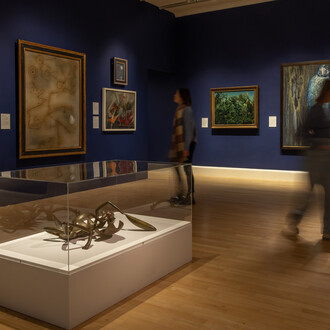This spring, National Museums Scotland celebrates the 400th anniversary of one of Scotland’s most significant contributions to science with a small exhibition dedicated to the life and legacy of John Napier, Power of Ten: Inventing Logarithms.
Four hundred years ago, John Napier’s (1550-1617) ground-breaking publication Mirifici Logarithmorum Canonis descriptio, introduced one of the most important advances in the study and practical application of mathematics: logarithms.
For over 20 years, Napier worked on developing methods of simplifying previously laborious and error-prone calculations. The result was a momentous invention which revolutionised mathematics from the 17th century to the present day. Through his tables of logarithms, the introduction of the decimal point and his calculating ‘rods’ or ‘bones’, Napier enabled more calculations to be completed in an hour than had previously been completed in one day.
Power of Ten: Inventing Logarithms will explore the myths and legacies of this remarkable man through books, mathematical apparatus and other artefacts. Objects range from first editions of his Mirifici Logarithmorum Canonis Descriptio (1614) on loan from the Crawford Collection of the Royal Observatory Edinburgh, and his later work Rabdologiae, seu numerationis per virgulas libri duo (1617), on loan from Edinburgh Napier University, to fine examples of Napier’s rods, slide-rules and pocket calculators from National Museums Scotland’s own collections.
Tacye Phillipson, Curator of Science at National Museums Scotland said: “We are delighted to celebrate the 400th anniversary of John Napier’s great invention with a new exhibition at the National Museum of Scotland, Power of Ten: Inventing Logarithms. This is an exhibition about avoiding doing arithmetic. Through his hard work and determination, Napier devised elegant solutions to previously long and tedious calculations which made them quicker, easier, and more widely accessible. This small exhibition will show all the effort that has gone to ensure we no longer have to do tricky calculations with quill and ink!”
Napier’s rapid method of calculation had a direct influence on the work of some of the greatest minds, from the great mathematician and astronomer Johannes Kepler (who revered Napier’s work during his own lifetime), to Sir Isaac Newton and even the Scottish philosopher David Hume, who wrote of Napier that he was “The person to whom the title of a Great Man is more justly due than to any other whom this country ever produced.” In testament to the legacy of logarithms, slide-rules, a direct product of Napier’s invention, were used by every school child as a shortcut to long multiplication and division until the mid-1970s.
As a Renaissance scholar, Napier’s interests and expertise ranged from philosophy, religion and politics, to astronomy, military invention and agricultural improvement. His wide-ranging skills led to his nickname ‘Marvellous Merchiston’.
He lived during an age of discovery when there were very fine lines between different disciplines – there would have been little distinction between astronomy and astrology for example. As a man of science it was acceptable that Napier also had an academic interest in alchemy and the occult. As such he earned an historical reputation for being something of a warlock. His pet black cockerel was considered by many as a familiar – a supernatural being which assisted witches and wizards in their magical practice.
The exhibition will be accompanied by a series of events and talks, including events in the 2014 Edinburgh International Science Festival programme.
A biography on Napier, John Napier: Logarithm John, written by Lynne Gladstone-Millar and published by NMSE Publishing Ltd, is also available in the National Museum of Scotland giftshops and online.
Power of Ten: Inventing Logarithms is part of Napier 400, a programme of events and exhibitions celebrating the 400th anniversary of the invention of logarithms, in association with Edinburgh Napier University and the Royal Society of Edinburgh.
All images © National Museums Scotland








![Edouard Vuillard
La causette [The Chat]](http://media.meer.com/attachments/f9be435eb0f83b6dc7f0cb0d44670d68f2d329b5/store/fill/330/330/fbf0806384f818ab496d752a584177a5958393ce1831462675cb5886c0cc/Edouard-Vuillard-La-causette-The-Chat.jpg)










